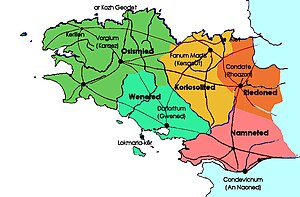Namnetes

TheNamneteswere aGallictribe dwelling near the modern city ofNantesduring theIron Ageand theRoman period.
Name
[edit]They are mentioned asNamnitō͂n(Ναμνιτῶν) byPolybius(2nd c. BC) andStrabo(early 1st c. AD),[1]NamnetesbyCaesar(mid-1st c. BC) andPliny(1st c. AD),[2]and asNamnē͂tai(Ναμνῆται) byPtolemy(2nd c. AD).[3][4]
The etymology of theethnonymNamnetesremains uncertain.Xavier Delamarrehas tentatively proposed to interpret the name as 'those of the river', by deriving it from theProto-Indo-Europeanroot *nem-('curved, bend'), which also gave the Gaulish stemnantu- ('valley, stream').[5]The elementnamn- inNamneteshas also been compared to river names such as theNamn-asain northern Spain and theNemun-asin Lithuania.[5][6]According toBlanca María Prósper,however, "Namnetes is alocus desperatusof Celtic etymology, and to judge from its overall look it probably contains a negative particle. Ethnic names often have an exotic, for us hardly understandable, and usually more complex look than place or river names. "[6]
Geography
[edit]
The Namnetes dwelled between the lowerLoire,theVilaineand theSemnonrivers.[7]Their territory was situated west of theAndecavi,south of theVenetiandRedones,and north of thePictones.[8]
Their chief town was Condevincum, corresponding to the modern city ofNantes,and their chief port was known as Portus Nemetum.[7]
History
[edit]In the spring 56 BC, during theGallic wars,the Namnetes allied to the Veneti to fight against the fleet made byCaesar.[7]Decimus Brutus, leader of the Roman fleet, won in the decisiveBattle of Morbihan.[9]
Samnitae/Namnete Women's Island
[edit]According toStrabo,quotingPoseidonios,there is an island in the Ocean near the outlet of the Loire river which was inhabited by the "women of the Samnitae," which is generally taken to be a mistake and actually refers to the "Namnitae" or Namnetes.[10]No man was ever allowed on the island and the women themselves sailed from it to have intercourse with men on the continent before returning there again. They also had the strange custom of unroofing their temple every year and roofing it again on the same day before sunset, each woman bringing her load to add to the roof. The woman whose load would fall out of her arms was rent to pieces by the rest, and they allegedly carried the pieces round the temple with the cry of "Ev-ah" in a frenetic manner.[11]
According to French archaeologistJean-Louis Brunaux,there are three reasons to consider the story as factual. First, the wet and windy climate of Western Gaul suggest that the Gallic dwellings (made of branches or reed) were re-roofed every year. Second, not to drop new material was, according toPliny the Elder,a common religious practice of the Celts. Third,circumambulationexisted as a rite among the Celts according toPoseidonios.[12]
References
[edit]- ^Polybius.Historíai,34:10:6;Strabo.Geōgraphiká,4:2:1.
- ^Caesar.Commentarii de Bello Gallico,3:9:10;Pliny.Naturalis Historia,4:107.
- ^Ptolemy.Geōgraphikḕ Hyphḗgēsis,2:8:8
- ^Falileyev 2010,s.v.Namnetes,Civitas NamnetumandPortunamnetu.
- ^abDelamarre 2003,pp. 231–232.
- ^abPrósper 2013–2014,p. 123.
- ^abcLafond & Olshausen 2006.
- ^Talbert 2000,Map 7: Aremorica, Map 14: Caesarodunum-Burdigala.
- ^Julius Caesar, III, 14
- ^The dichotomy Samnitoi-Namnitoi is also present in Ptolemy's Geography: he writes that the Namnitoi live "south of the Veneti" while the "Namnitoi" are far in the east of the Andecavi and theCenomani.
- ^Strabo,Geography,IV, 4, 6
- ^Jean-Louis Brunaux.Les Druides. Des philosophes chez les barbares.Paris, Seuil, 2006, p. 241
Bibliography
[edit]- Delamarre, Xavier(2003).Dictionnaire de la langue gauloise: Une approche linguistique du vieux-celtique continental.Errance.ISBN9782877723695.
- Falileyev, Alexander (2010).Dictionary of Continental Celtic Place-names: A Celtic Companion to the Barrington Atlas of the Greek and Roman World.CMCS.ISBN978-0955718236.
- Lafond, Yves; Olshausen, Eckart (2006). "Namnetae".Brill's New Pauly.doi:10.1163/1574-9347_bnp_e816580.
- Prósper, Blanca María (2013–2014). "Time for Celtiberian dialectology: Celtiberian syllabic structure and the interpretation of the bronze tablet from Torrijo del Campo, Teruel (Spain)".Keltische Forschungen.6:109–148.
- Talbert, Richard J. A.(2000).Barrington Atlas of the Greek and Roman World.Princeton University Press.ISBN978-0691031699.

